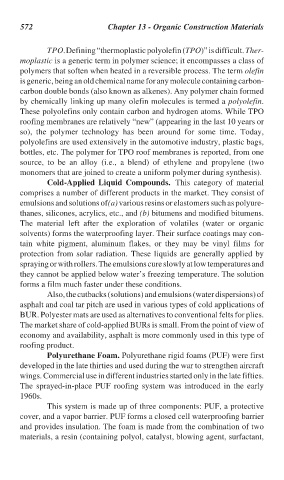Page 605 - Handbook of Thermal Analysis of Construction Materials
P. 605
572 Chapter 13 - Organic Construction Materials
TPO. Defining “thermoplastic polyolefin (TPO)” is difficult. Ther-
moplastic is a generic term in polymer science; it encompasses a class of
polymers that soften when heated in a reversible process. The term olefin
is generic, being an old chemical name for any molecule containing carbon-
carbon double bonds (also known as alkenes). Any polymer chain formed
by chemically linking up many olefin molecules is termed a polyolefin.
These polyolefins only contain carbon and hydrogen atoms. While TPO
roofing membranes are relatively “new” (appearing in the last 10 years or
so), the polymer technology has been around for some time. Today,
polyolefins are used extensively in the automotive industry, plastic bags,
bottles, etc. The polymer for TPO roof membranes is reported, from one
source, to be an alloy (i.e., a blend) of ethylene and propylene (two
monomers that are joined to create a uniform polymer during synthesis).
Cold-Applied Liquid Compounds. This category of material
comprises a number of different products in the market. They consist of
emulsions and solutions of (a) various resins or elastomers such as polyure-
thanes, silicones, acrylics, etc., and (b) bitumens and modified bitumens.
The material left after the exploration of volatiles (water or organic
solvents) forms the waterproofing layer. Their surface coatings may con-
tain white pigment, aluminum flakes, or they may be vinyl films for
protection from solar radiation. These liquids are generally applied by
spraying or with rollers. The emulsions cure slowly at low temperatures and
they cannot be applied below water’s freezing temperature. The solution
forms a film much faster under these conditions.
Also, the cutbacks (solutions) and emulsions (water dispersions) of
asphalt and coal tar pitch are used in various types of cold applications of
BUR. Polyester mats are used as alternatives to conventional felts for plies.
The market share of cold-applied BURs is small. From the point of view of
economy and availability, asphalt is more commonly used in this type of
roofing product.
Polyurethane Foam. Polyurethane rigid foams (PUF) were first
developed in the late thirties and used during the war to strengthen aircraft
wings. Commercial use in different industries started only in the late fifties.
The sprayed-in-place PUF roofing system was introduced in the early
1960s.
This system is made up of three components: PUF, a protective
cover, and a vapor barrier. PUF forms a closed cell waterproofing barrier
and provides insulation. The foam is made from the combination of two
materials, a resin (containing polyol, catalyst, blowing agent, surfactant,

